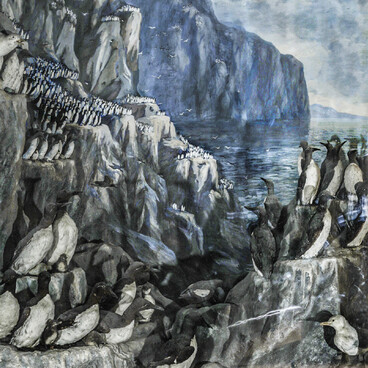In the ravines near Moscow one can find the fossilized remains of extinct cephalopods (class Cephalopoda): belemnites from the subclass Coleoidea and ammonites from the subclass Ammonoidea (Ammonoidea).
The very first ammonites on Earth appeared in the Early Devonian of the Paleozoic era, about 400 million years ago. They reached their peak of development in the Mesozoic era flourishing until its end, and at the end of the Cretaceous period, which was about 66 million years ago, they became extinct along with the dinosaurs.
Throughout the Mesozoic era, ammonites were an extremely numerous and diverse group of carnivorous animals. Nowadays, this is the name for all cephalopods with complex corrugated folded septa. This structure increased the strength of the shell and held back water pressure.
Most ammonites had an external shell, which consisted of several whorls located in the same plane. The turns could touch or overlap each other. Such shells are called monomorphic. In the Cretaceous, ammonites with a heteromorphic shell of an irregular shape began to occur more often.
The ammonite shell was divided into numerous chambers; the mollusk itself lived in the one closest to the mouth. Most of the chambers were filled with gas; some remained hydrostatic and were filled with liquid.
In the present day, the preserved remains of ammonites help scientists explore the geological layers: this information is used, in particular, when searching for minerals. In paleontology, these species are called ‘guiding fossils’, they can be representatives of both fauna and flora. Such species differ from others in their short life span on the scale of geological time, as well as widespread on the planet.
Since the ammonites lived and multiplied for only a few tens or hundreds of thousands of years, their remains are found only in layers of a certain age. Moreover, their species quickly replaced each other. Many of the ammonites swam well, which meant that they could travel across the vast seas of the Mesozoic and live in places far enough from each other. Nowadays, researchers can determine from the fossil ammonites the age of the layer in which they were found.
The very first ammonites on Earth appeared in the Early Devonian of the Paleozoic era, about 400 million years ago. They reached their peak of development in the Mesozoic era flourishing until its end, and at the end of the Cretaceous period, which was about 66 million years ago, they became extinct along with the dinosaurs.
Throughout the Mesozoic era, ammonites were an extremely numerous and diverse group of carnivorous animals. Nowadays, this is the name for all cephalopods with complex corrugated folded septa. This structure increased the strength of the shell and held back water pressure.
Most ammonites had an external shell, which consisted of several whorls located in the same plane. The turns could touch or overlap each other. Such shells are called monomorphic. In the Cretaceous, ammonites with a heteromorphic shell of an irregular shape began to occur more often.
The ammonite shell was divided into numerous chambers; the mollusk itself lived in the one closest to the mouth. Most of the chambers were filled with gas; some remained hydrostatic and were filled with liquid.
In the present day, the preserved remains of ammonites help scientists explore the geological layers: this information is used, in particular, when searching for minerals. In paleontology, these species are called ‘guiding fossils’, they can be representatives of both fauna and flora. Such species differ from others in their short life span on the scale of geological time, as well as widespread on the planet.
Since the ammonites lived and multiplied for only a few tens or hundreds of thousands of years, their remains are found only in layers of a certain age. Moreover, their species quickly replaced each other. Many of the ammonites swam well, which meant that they could travel across the vast seas of the Mesozoic and live in places far enough from each other. Nowadays, researchers can determine from the fossil ammonites the age of the layer in which they were found.



